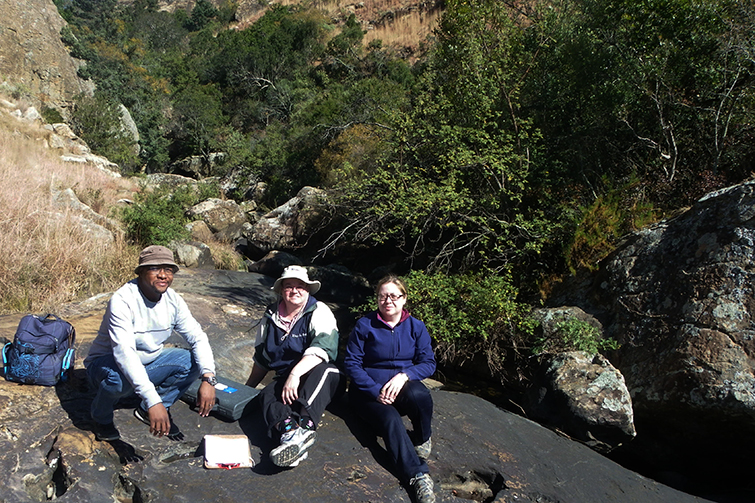04 January 2021
|
Story Andre Damons
|
Photo Supplied
 From left to right: Makashane Ntlhabo (PhD student at the Centre for Gender and Africa Studies), Dr Tascha Vos (Centre for Environmental Management) and Dr Stephanie Cawood (Centre for Gender and Africa Studies).
From left to right: Makashane Ntlhabo (PhD student at the Centre for Gender and Africa Studies), Dr Tascha Vos (Centre for Environmental Management) and Dr Stephanie Cawood (Centre for Gender and Africa Studies).
Two researchers from the University of the Free State (UFS) are studying how water quality could be used at informal heritage sites to measure the health of the sites. They are also aiming to test the workability of their Rapid Integrity Appraisal (RIA) bio-cultural screening model as a way to safeguard informal heritage sites and cultural heritage.
Dr Stephanie Cawood from the Centre for Gender and Africa Studies and Dr Tascha Vos from the Centre for Environmental Management,a limnologist with a doctorate in environmental management, hope to achieve wider application for the RIA model beyond the eastern Free State’s sacred sites and to consider the feasibility of RIA to inform the monitoring and management regimes of formal heritage sites as well.
This interdisciplinary research is unique and brings together the science of aquatic ecology (limnology) as well as the cultural and social human dynamics of heritage, pilgrimage and ritual and how they interact.
Sacred sites and places of pilgrimage
“In previous research, we documented a link between the environmental integrity and public health of informal heritage sites in the eastern Free State and the cultural heritage associated with these sites. They are considered sacred sites and places of pilgrimage and include various sacred valleys and caves in the Mohokare Valley in the eastern Free State along the South Africa-Lesotho border.
“We detected a cycle of risk between human, animal and ecological risk factors where water quality is representative of ecological risk and cultural practices associated with the intrinsic heritage of the sites. Based on this cycle of risk and conventional aquatic biomonitoring models, we developed a unique bio-cultural screening model called Rapid Integrity Appraisal specifically designed for the biomonitoring of informal heritage sites such as the eastern Free State sacred sites,” the two researchers explain.
Rapid Integrity Appraisal
According to Dr Cawood, who is very knowledgeable about pilgrimage movement in the Mohokare Valley and has conducted regular fieldwork trips to these sites from 2007-2010, RIA is a bio-cultural screening model to determine the need for intervention at informal heritage sites.
Says Dr Cawood: “Ideally, a complete bio-cultural screening model would include all existing bio-monitoring indices. However, in a country such as South Africa which has immense social challenges, the formal heritage sector is under-resourced. Resources are even scarcer for informal heritage management.”
Dr Vos says this means that the full spectrum of biomonitoring indices simply cannot be justified for informal heritage sites. Therefore, in the specific context of limited resources in terms of time, expertise and funding, a pragmatic view has to be taken to rapidly and efficiently assess the integrity of informal sites.
“We found certain analyses related to water quality more valuable for extrapolation than others and we conceptualised these parameters as forming the RIA model. The idea behind RIA was to find the most expedient and efficient mode to rapidly assess the integrity of a particular informal heritage site. RIA is not meant to be a comprehensive method but is rather aimed at collecting baseline data for immediate decision-making and the possible implementation of a full water-quality assessment, or perhaps a complete bio-cultural screening,” according to Dr Vos.
Great potential
They have recently been funded by the UFS for this interesting interdisciplinary project which started in 2018. They have already completed the fieldwork and are now left with the data analysis and interpretation and the writing of articles. Unfortunately, the coronavirus pandemic negatively affected their progress in this regard, but they hope to finalise the project next year.
According to the researchers the project has great potential for application in heritage management anywhere, not only for the monitoring of informal heritage sites, but for poorly managed tourist sites that may be ecologically compromised.